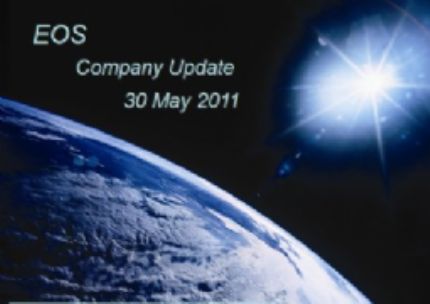
Electro Optic Systems Holdings Limited (ASX:EOS) Wins Space Contract
Canberra, Aug 24, 2011 AEST (ABN Newswire) - Electro Optic Systems Holdings Limited ( ASX:EOS) has this week been awarded a $3 million Department of Defence Concept Technology Demonstrator (CTD) contract to demonstrate that its electro-optic space surveillance sensors integrate and operate effectively with existing space surveillance sensors.
ASX:EOS) has this week been awarded a $3 million Department of Defence Concept Technology Demonstrator (CTD) contract to demonstrate that its electro-optic space surveillance sensors integrate and operate effectively with existing space surveillance sensors.
In the period 2005-2010 the EOS sensors, based on laser and optical technology, had demonstrated all the performance expected for next-generation space tracking requirements, except [a] operational cost-effectiveness and [b] the ability to operate with existing infrastructure.
Since 2010 EOS has been engaged under Australian Space Research Program (ASRP) funding of $4.3 million to demonstrate the operational cost-effectiveness of its space surveillance sensors, principally through fully automated operation of sensors capable of long-range and accurate tracking. These operational extensions will be completed in 2012.
The Defence Concept Technology Demonstrator (CTD) contract, announced today by the Minister for Defence Science and Personnel, Warren Snowdon, will now require those sensors to be tested in real-time operations with existing space surveillance radars, to establish that new sensors can operate effectively within existing tracking infrastructure which represents many billions of dollars of investment.
"This project seeks to show how precision laser tracking systems can co-operate with radar tracking systems to detect and then pin-point space objects. Once the laser has a lock on the object, it can determine the orbit with high precision," Said Dr Craig Smith, CEO of EOS Space Systems Pty Limited, the EOS subsidiary undertaking the effort.
Knowing the precise track of space objects is critical for satellite operators to avoid costly collisions in orbit."
NASA and ESA (European Space Agency) studies estimate that there are at least 300,000 uncontrolled objects of 1cm diameter or larger orbiting the Earth. Each of these objects is capable of causing catastrophic damage should they collide with an active satellite. Much of modern life and defence capability depend upon satellites, and EOS' technology offers the potential to better protect these valuable assets.
"Satellites are vital to so much or our daily lives," said Smith. "Everything from your car's GPS signal to international commerce and many TV shows, depend upon satellites. And, of course, satellites are integral to many vital military systems. Avoiding collisions in space is paramount and knowing the location of space junk is obviously fundamental to collision avoidance."
The US North American Aerospace Defence system uses radars to track a number of the larger objects and orbit predictions generated from these tracks are used to assess likely collisions. If feasible, active satellites manoeuvre to avoid potential collisions.
"The failure to predict the recent collision between an active Iridium satellite and a large debris object (Cosmos) has shown that the orbit predictions generated from current radar data alone do not provide sufficient accuracy to reliably predict all collisions. A means to improve the accuracy of satellite and debris orbit predictions is required if future collisions are to be predicted and avoided," said Dr Smith.
Over the past 20 years EOS has developed techniques and technology which uses active laser tracking to provide extremely accurate (within one metre) measurements of small space debris and satellite orbits. This capability significantly enhances the accuracy of orbits and collision avoidance predictions.
The CTD Contract announced today will involve the expertise of EOS and its partner Northrop Grumman to examine how EOS' Australian-based sensors could be linked to US-based radar to track space objects more accurately and effectively than either system could achieve alone.
The CEO of EOS Dr Ben Greene, commenting on the awarding of the contract said: "There is a very large international investment in space surveillance radar technology, and this infrastructure will continue to operate well into the future. However EOS sensors can augment and enhance the operational effectiveness of these existing investments to provide timely and efficient collision avoidance.
"There is little doubt that radar and optical technologies can each deliver key parts of the overall solution for safe satellite operation in space. However this contract represents the first time the combined operation of these systems will be operationally tested.
"We expect this will be a major step towards the long-term protection of valuable space assets, and the preservation and conservation of the vital space environment," Dr Greene added.
Contact
Ben Greene
Chief Executive Officer EOS
Mob: +61-414-365-658
Craig Smith
Chief Executive Officer EOS Space Systems
Ph: +61-414-365-368
http://www.eos-aus.com
| ||
|







